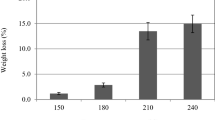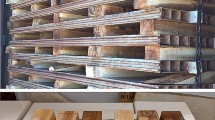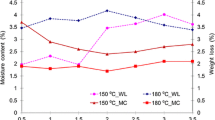Abstract
Plantation grown Hevea brasiliensis (rubberwood) was thermally processed in a vacuum-pressure oven in the temperature range of 150–240 °C under two inert environments (vacuum and nitrogen gas) and normal atmospheric pressure (air). Effect of heat treatments on various physical properties of rubberwood such as equilibrium moisture content (EMC), specific gravity, water uptake, shrinkage, colour and surface roughness profiles was evaluated and compared with untreated wood. The EMC of rubberwood was found to be reduced by almost half while specific gravity was reduced slightly after heat treatment. The intensity of darker brown colour was increased with increasing heat treatment temperatures and colour change was observed to be uniform throughout the wood blocks. Dimensional stability, water resistance, colour and surface quality were observed to be improved after thermal processing of rubberwood at moderately high temperatures under inert environments without affecting other properties deleteriously. Based on improved properties, heat treated rubberwood was found to be suitable for nonstructural applications such as flooring, siding, paneling etc.








Similar content being viewed by others
References
Anon (1986) IS:1708. Indian standard for ‘Methods of testing small clear specimens’. Bureau of Indian Standards, New Delhi
Anon (1989) IS:3670. Indian standard for ‘Construction of timber floors-code of practice.’ (First Revision). Bureau of Indian Standards, New Delhi
Anon (2003) ThermoWood Handbook, Finnish Thermowood Association, Wood Focus Oy, Helsinki
Anon (2012) Mitutoyo surface roughness tester-Mitutoyo Surftest SJ-401. Mitutoyo Corporation, Kawasaki
Ayrilmis N, Jarusombuti S, Fueangvivat V, Bauchongkol P (2011) Effects of thermal treatment of rubberwood fibres on physical and mechanical properties of medium density fibreboard. J Trop For Sci 23(1):10–16
Boonstra MJ, Van Acker J, Pizzi A (2007) Anatomical and molecular reasons for property changes of wood after full-scale industrial heat-treatment. In: Proceedings third European conference on wood modification, Cardiff, 15–16th Oct 2007, pp 343–358
Bourgois J, Janin J, Guyonnet R (1991) The color measurement: A test method to study and to optimize the chemical transformations undergone in the thermally treated wood. Holzforschung 45(5):377–382
Dwianto W, Inoue M, Tanaka F, Norimoto M (1996) The permanent fixation of compressive deformation in wood by heat treatment. In: Proceedings from the third pacific rim bio-based composites symposium, Kyoto, pp 231–239
Emmler R, Scheiding W (2007) Darker shades of wood: thermally modified timber (TMT) as a new material for parquet floorings. Eur Coat J 4:106–111
González-Peña MM (2012) Improvement of the biological performance and dimensional stability of two tropical woods. Paper presented in 43rd IRG Annual Meeting, Kuala Lumpur, Malaysia, 6–10 May, IRG/WP 12-40605. The International Research Group on Wood Protection, Stockholm
Gunduz G, Korkut S, Korkut DS (2008) The effects of heat treatment on physical and technological properties and surface roughness of Camiyanı Black Pine (Pinus nigra Arn. subsp. pallasiana var. pallasiana) wood. BioRes Technol 99:2275–2280
Hill CAS (2006) Wood modification—chemical, thermal and other processes. Wiley, Chichester 239
Hillis WE (1984) High temperature and chemical effects on wood stability. I. General considerations. Wood Sci Technol 18(4):281–293
Hofmann T, Retfalvi T, Albert L, Niemz P (2008) Investigation of the chemical changes in the structure of wood thermally modified within a nitrogen atmosphere autoclave. Wood Res 53(3):1–14
Hsu WE, Schwald W, Schwald J, Shields JA (1988) Chemical and physical changes required for producing dimensionally stable wood-based composites. Part I: steam pretreatment. Wood Sci Technol 22:281–289
Kamdem DP, Pizzi A, Jermanaud A (2002) Durability of heat-treated wood. Holz Roh Werkstoff 60(1):1–6
Korkut S, Akgul M (2007) Effect of drying temperature on surface roughness of oak (Quercus petraea Steven ex Bieb Krassiln) veneer. Build Environ 42(5):1931–1935
Metsa-Kortelainen S, Antikainen T, Viitaniemi P (2006) The water absorption of sapwood and heartwood of Scots pine and Norway spruce heat-treated at 170 °C, 190 °C, 210 °C and 230 °C. Holz Roh- Werkstoff 64:192–197
Niemz P, Bekhta P (2003) Effect of high temperature on the changes in color, dimensional stability and mechanical properties of spruce wood. Holzforschung 57(5):539–546
Niemz P, Hofmann T, Retfalvi T (2010) Investigation of chemical changes in the structure of thermally modified wood. Maderas-Ciencia Y Tecnologia 12(2):69–78
Obataya E, Tomita B (2002) Hygroscopicity of heat-treated wood. II Reversible and irreversible reductions in the hygroscopicity of wood due to heating. Mokuzai Gakkaishi 48(4):288–295
Obataya E, Tanaka F, Norimoto M, Tomita B (2000) Hygroscopicity of heat-treated wood I: effects of after-treatments on the hygroscopicity of heat-treated wood. Mokuzai Gakkaishi 46(2):77–87
Rep G, Pohleven F (2001) Wood modification–a promising method for wood preservation. Drvna industrija 52(2):71–76
Repellin V, Guyonnet R (2005) Evaluation of heat-treated wood swelling by differential scanning calorimetry in relation to chemical composition. Holzforschung 59:28–34
Sailer M, Rapp AO, Leithoff H, Peek RD (2000) Upgrading of wood by application of an oil heat treatment. Holz als Roh Werkstoff 58(1/2):15–22
Sundquist B (2004) Colour changes and acid formation in wood during heating. Doctoral thesis. Divisions of Wood Material Science. Lulea University of Technology, Skellefta
Zivkovic V, Prsa I, Turkulin H, Sinkovic T, Jirous-Rajkovic V (2008) Dimensional stability of heat treated wood floorings. Drvna Industrija 59(2):69–73
Acknowledgments
The authors are thankful to the Director, Institute of Wood Science and Technology, Bangalore for his keen interest in the research work. Valuable technical help from the staff of WPU and WFP divisions of IWST rendered for testing of wood samples is duly acknowledged.
Author information
Authors and Affiliations
Corresponding author
Rights and permissions
About this article
Cite this article
Shukla, S.R., Sharma, S.K. Effect of high temperature processing under different environments on physical and surface properties of rubberwood (Hevea brasiliensis). J Indian Acad Wood Sci 11, 182–189 (2014). https://doi.org/10.1007/s13196-014-0135-x
Received:
Accepted:
Published:
Issue Date:
DOI: https://doi.org/10.1007/s13196-014-0135-x




